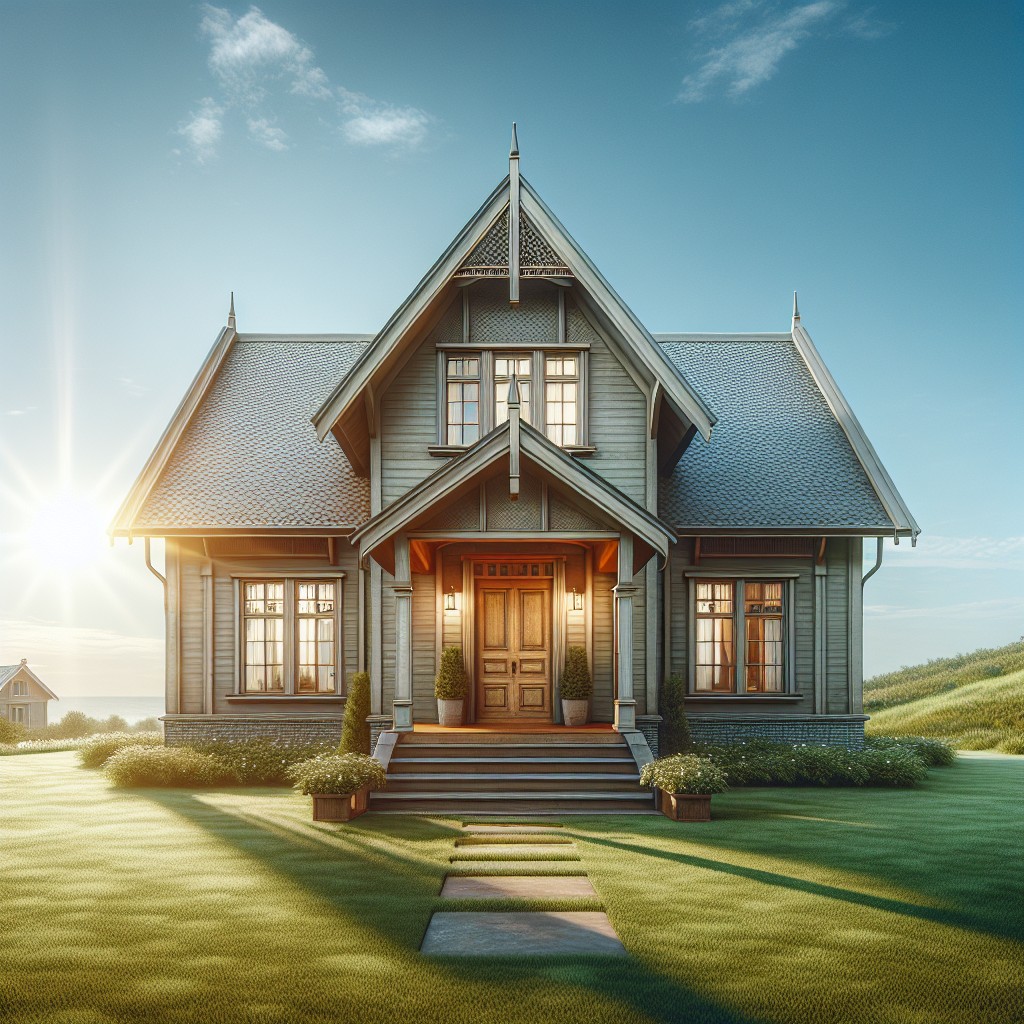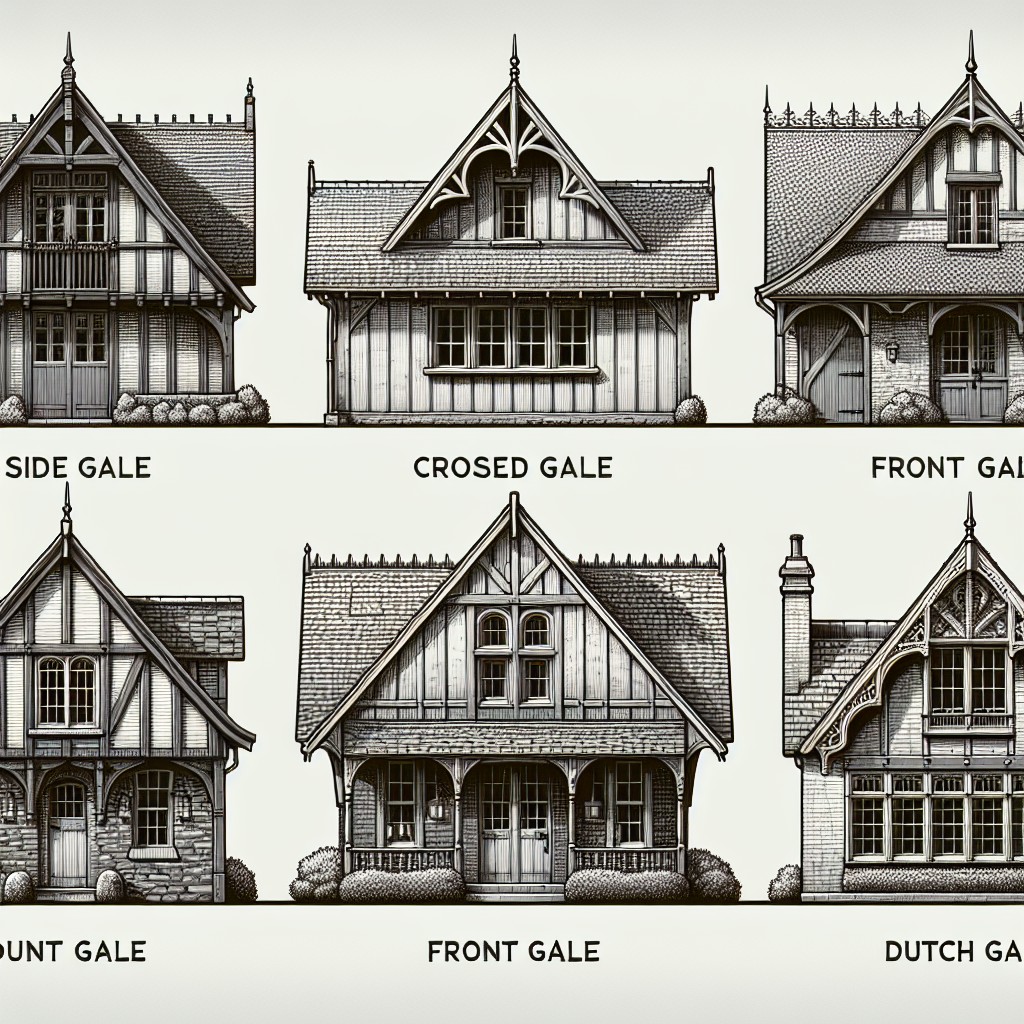Last updated on
Explore the pros and cons of gable roofs because understanding these factors proves indispensable while choosing the ideal roof design for residential or commercial structures.
Key takeaways:
- Gable roofs offer versatility and complement various architectural styles.
- Steep pitch facilitates water and snow runoff, providing extra space.
- Gable roofs are cost-effective and quicker to construct.
- Vulnerable to high winds, limited attic space, and water leakage.
- Gable roofs compared to hip roofs: aesthetics, durability, drainage, cost.
What Is a Gable Roof?

A gable roof, often recognized by its triangular shape, is one of the most common roof designs in temperate climates. This structure consists of two sloping sides that come together at a ridge, creating end walls with a triangular extension, known as a gable, at the top.
The simplicity of its design allows for easier construction and efficient water drainage. Furthermore, the pitched shape provides ample space for an attic or vaulted ceilings, offering additional living or storage space. The gable roof’s versatility makes it compatible with a wide range of architectural styles, from traditional to contemporary.
Types of Gable Roofs

Cross Gable Roof: Features two or more gable rooflines that intersect at an angle, often seen in houses with complex layouts.
Box Gable Roof: Presents a triangular extension at each end of the house, with the roof section boxed at the end which gives it a more ridged appearance.
Front Gable Roof: Typically placed at the entrance of the house, this design is common in Colonial-style homes where the gable faces the street.
Dutch Gable Roof: A hybrid that combines the strengths of both gable and hip roofs, featuring a gable (or peak) set atop a hip roof for added space and aesthetic appeal.
Flying Gable Roof: A modern design where the gable overhangs the roofline, giving the appearance that it’s ‘flying’ due to the lack of support beneath the overhang.
Gable Roof Advantages
Gable roofs boast a classic, triangular shape, making them instantly recognizable and aesthetically pleasing; this simple design not only contributes to curb appeal but also provides the versatility to complement various architectural styles, from colonial to contemporary.
Their steep pitch facilitates efficient water and snow runoff, reducing the likelihood of water pooling and potential damage. This characteristic also creates additional attic space or vaulted ceilings, providing homeowners with extra storage or living area.
Moreover, the straightforward construction of gable roofs often leads to reduced build times and lower costs, as the design requires fewer materials and can be easily adapted to varying house dimensions. These advantages, coupled with the ease of ventilation that this roof type offers, ensure that gable roofs remain a popular choice for regions experiencing heavy rainfall and snow.
Gable Roof Disadvantages
While gable roofs are widely popular for their simplicity and other benefits, they do present several challenges and limitations.
Susceptibility to High Winds: The design of a gable roof can make it vulnerable in hurricane-prone regions or areas with high-speed winds. The overhang of the gable can catch wind much like a sail, potentially leading to uplift and even roof detachment if not properly constructed with adequate reinforcement.
Limited Attic Space: The triangular shape of a gable roof can restrict the amount of usable attic space. This may impact storage capacity or the feasibility of an attic conversion into a livable area.
Structural Support Concerns: Without the proper support, the gable ends (also known as gable walls) can develop issues due to the pressure exerted by the roof pitch. This may lead to cracking or bowing over time, particularly if materials have not been correctly chosen or installed.
Water Leakage: If not well-sealed at the ridge and the roof’s peak, gable roofs can be prone to water leaks. This is especially true in areas that face heavy rain or snow, which can penetrate if roof flashing is not correctly installed.
Aesthetic Versatility: Gable roofs may offer fewer design variations compared to other roofing styles. This can limit architectural expression, especially in neighborhoods where differentiation is sought after.
Understanding these drawbacks is crucial in determining whether a gable roof is the best fit for a particular structure. Proper construction techniques and maintenance are key in mitigating these disadvantages to ensure the longevity and performance of a gable roof.
Comparison: Gable Roof Vs. Hip Roof
When contrasting the two popular roofing styles, several key points emerge:
Structure:
- Gable roofs have two sloping sides that meet at a ridge, creating a triangle-shaped end wall known as a gable.
- Hip roofs feature slopes on all four sides, which come together at the top to form a ridge.
Aesthetics:
- Gable roofs offer a classic, picture-book home appearance.
- Hip roofs have a more subtle, subdued look with their gentle slopes.
Durability:
- Hip roofs generally withstand high winds and heavy snowfall better due to the inward slope of all four sides.
- Gable roofs may be more susceptible to wind damage if not adequately braced.
Water Drainage:
- Both roof types offer excellent water drainage capabilities; however, the hip roof’s design minimizes the potential for leaks due to less reliance on vertical walls.
Cost:
- Gable roofs are often less complex and less expensive to construct.
- Hip roofs require more materials and labor, resulting in higher construction costs.
Each roofing type has unique benefits and potential drawbacks, and the choice between them will ultimately depend on factors such as geographic location, weather conditions, and personal preference for aesthetic appeal.
FAQ
What are 3 advantages of a gable roof?
Gable roofs are excellent for providing favorable drainage, better weather resistance, and improving ventilation in the house.
What are the disadvantages of a gable roof?
Gable roofs can prove unsuitable for certain climates, specifically those with extreme rainfall, heavy winds, and significant snowfall, due to their tendancy to struggle under these conditions.
What are some disadvantages of a gable roof?
Gable roofs can pose issues in areas of high wind or hurricanes due to potential collapse if not adequately supported, and risk of materials peeling away due to strong winds.
What are the pros and cons of cross gable roofs?
Pros of cross gable roofs include their suitability for complex property layouts, ability to highlight entrances or porches, and flexibility in pitch height, while their cons involve being more expensive due to complexity.
How does the design of a gable roof improve water drainage and snow removal?
The design of a gable roof, with its steep slope, improves water drainage and snow removal by allowing rainwater and snow to slide off easily.
What factors make a gable roof an energy-efficient choice?
Gable roofs are energy-efficient due to their simple design that facilitates proper ventilation and allows for efficient insulation, reducing heating and cooling costs.
Are there challenges associated with ventilation and insulation in gable roofs?
Yes, gable roofs often face challenges related to ventilation and insulation, such as condensation buildup and temperature inconsistencies due to improper airflow and lack of adequate insulation materials.





